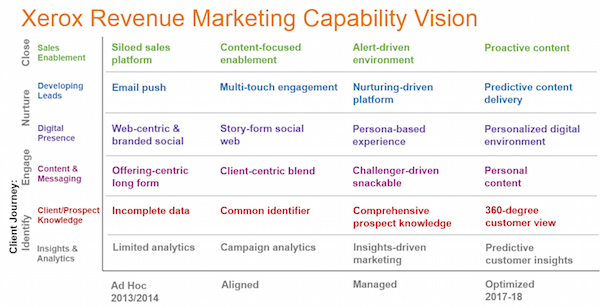Happy New Year, dear readers!
What better way to launch into 2017 than revisiting our good friend Mayur Gupta, truly one of the icons of the marketing technology world.
Over the history of this blog, some of the most fascinating stories to me have been observing how things change over time. One is the growth of the marketing technology landscape, as it’s blossomed from 2011, 2012, 2014, 2015, and 2016 (and, yes, 2017 is on the way).
Mayur’s career is another one of those ongoing stories. I first met him in 2012, when he was a marketing technology & strategy director at SapientNitro — a technologist building software for marketers. I published my first Q&A with him in January 2013 as he took on the role of global head of marketing technology at Kimberly-Clark — essentially one of the world’s first chief marketing technologists. I then profiled him in the summer of 2014 for the Harvard Business Review article, Rise of the Chief Marketing Technologist. We then did another Q&A together in September 2015 after he became the SVP and head of digital at Healthgrades.
And now, he’s the global vice president for growth & marketing at Spotify. (Congratulations!)
To me, Mayur is the archetype of the hybrid marketing and technology executive for this decade. He’s blended those two discipline masterfully, and watching his career take shape over the past 5 years has been a personified narrative of how “marketing” as a profession is being elevated and transformed. (I had his story in mind as I was writing my article last month on digital transformation as the #1 disruption to “marketing” underway.)
Without further ado, here’s Mayur’s perspective on marketing technology here in 2017…
1. We’ve been excitedly following your career arc as a kind of bellwether example for hybrid marketing technology executives. When we last checked in, you were the head of digital for Healthgrades. What prompted you to make this new move to Spotify?
It has indeed been a journey — satisfying and surprising at the same time. Having started off as an engineer and technologist many years back, it’s been a steady and gradual shift, first towards the intersection of marketing and technology, to now being right at the center of modern marketing.
Data, technology, and marketing are intertwined in this digital world, and my career, I believe, is a by-product of that evolution.
That is a reflection of the fundamental shift from the analog world I grew up in to the intrinsically digital world we all live in now. Technology has empowered the consumer with seamless discoverability and accessibility, redefining customer experience, which means marketing now has a very different role to play within organizations. Data, technology, and marketing are intertwined in this digital world, and my career, I believe, is a by-product of that evolution.
Somewhere during this journey, I realized that the hallmark of a great technologist or a marketer is their understanding and empathy towards the customer. Once you have that, you can deliver experiences that simplify and change lives.
Music in general is central to both, a reflection of human behavior and desire while having the power to change the same. This is how people connect with each other. Spotify provides that marketplace both for the fans and creators of music and creativity. At a time when there is so much disruption happening within the category, I have the opportunity to converge the science of data and technology with the art of marketing and storytelling.
2. Can you tell us more about your role at Spotify? Where does marketing technology fit into this?
The role is fairly straight forward: apply data-driven marketing to grow the business. For me, that simply means inspiring more fans to listen to more music more often and provide a frictionless ecosystem that enables more artists to create more music more often for more fans.
As the category gets more mature and fragmented, fans get more choice, forcing the brands to become more precise, relevant, and progressive about every single interaction, agnostic of channel or type of media.
The strategy to make that real will include all the ingredients of a data-driven marketing organization that works in partnership with product, content, and business teams. It requires the ability to listen and understand the human behavior and the unmet need at any given point in the journey and being able to meet it just in time. My role is to make that a reality.
I think of the entire ecosystem as a running engine, then marketing technology represents the pipes connecting the different pieces together.
Marketing technology is central to the engine. If I think of the entire ecosystem as a running engine, then marketing technology represents the pipes connecting the different pieces together, while data is the oil that flows through these pipes.
Without marketing technology or the pipes — I’m sure we will discuss microservices and APIs at some point — we lose the ability to listen, analyze and relevantly engage with the customer. What needs to be a connected ecosystem will only be a dispersed set of individual tools. We will have data and we will have content but no way to apply them to deliver a value proposition for the customer.
3. Now that you’ve worked with a variety of different companies, including board positions with more traditional firms, are there common patterns around the technological evolution of marketing that you’ve discerned?
It’s been really fascinating and eye opening revelation for me personally. I have had the benefit of working across the Fortune 100’s to Fortune 5000’s as well as growth companies in various capacities. Some of these companies are multi-billion-dollar CPG/retail firms and others span across health/dental care, digital, technology, and entertainment.
Regardless of the industry or their size and scale, every single one of them is on a very similar journey towards digital transformation and disruption — of course, at perhaps different stage of the journey.
The opportunities and challenges in this digital economy that center around the customer are extremely consistent and agnostic of the industry itself. If you have an underlying framework for digital transformation that may include becoming a data-driven agile organization or evolving the role of marketing to drive growth with art and science, you can shut your eyes and apply it across these industry verticals with minor tweaks.
The same applies to marketing and the growing role of data and technology within marketing. There is a very simple reason for all of this — the “customer.” We are operating in a customer-led era, and the moment organizations start to put the customer at the center of their ecosystem, these strategies become consistent.
Every brand and CMO now acknowledges that marketing and technology are intertwined. Technology is the interface of marketing.
For instance, very specifically around marketing technologies:
- Every brand and CMO now acknowledges that marketing and technology are intertwined. Technology is the interface of marketing. In many cases, technology is the experience. Enters “marketing technology” as a core function in 7 out of 10 companies now (my rough estimate).
- At the same time though, the challenges of a chaotic, fast-paced, and fragmented marketing technology landscape are equally obvious.
- Marketing departments now have the budget to purchase marketing technologies, but are struggling to maximize adoption and activation.
- However, there are organizations that have an advanced vision of a connected marketing technology ecosystem. They are able to drive tangible growth and lifetime value with data-driven engagement and always-on algorithmic experiences. They are already talking about a marketing operating system enabled through APIs, services, and data integration across internal and external systems.
4. You’ve brought a high level of technical sophistication to the marketing teams that you’ve worked with. Is that effectively a requirement for modern marketing success? What steps should companies that don’t yet have that in their DNA take to develop it?
Marketing, technology and data are inseparable – that’s no longer a question but a proven fact.
We are trying to serve an extremely modern customer who is technology dependent, not just technology savvy, living and operating in a connected digital world. Her expectations are soaring high. She has control, choice, and speed at her finger tips. She demands the highest value with the most immersive and personalized experience, along with a story that makes her the protagonist, not the brand.
Modern marketers need to converge data and technology with impeccable storytelling to drive customer engagement.
That’s a very high bar. Traditional models of mass marketing, where you talk at the customer to tell the brand story, perhaps saying you are unique, just like the other brand, can no longer meet the customer expectations. Modern marketers need to converge data and technology with impeccable storytelling to drive customer engagement — and do it every single time — to earn, not buy, loyalty.
There are many frameworks out there, from the 5Cs of Modern Marketing to MIT’s latest study to help organizations drive digital transformation.
However, I am not sure if there is a defined set of steps to drive the cultural shift other than to build a belief that the change and disruption has already happened. Organizations must either drive this fundamental digital transformation and change the business or eventually run out of business.
5. What about the evolution of marketing technology this year? For instance, what do you think of some of the recent discussion of microservices as an architecture for a company’s digital “operating system?”
It continues to amaze all of us — the exponential growth, the mergers, the acquisitions. Just when you think it will slow down, it goes faster.
We will not have the mother of all marketing technology companies under a single umbrella that will come out with a “marketing operating system.”
I think there are a few patterns I have noticed in the last 12-18 months:
- A realization that we will not have the mother of all marketing technology companies under a single umbrella that will come out with a “marketing operating system,” an mOS like iOS. We all had hoped for an Adobe, IBM, Oracle, Salesforce to make that a reality, but the pace of diversification is much higher than consolidation. The bar for innovation is so low today — there is a new technology idea every single day.
- This brings back a service-oriented architecture and an open framework right at the center of an ever-expanding ecosystem.
- Data becomes the linchpin that allows these technologies to align themselves in context to the customer journey, and data integration has become the most critical focal point.
- The latest acquisition of Apigee by Google is a reflection of that realization and industry maturity around the need to build scale through services and APIs.
As modern marketing becomes more and more algorithmic and programmatic across channels, the need for a marketing operating system that is connected through data and services will be inevitable.
6. We hear a lot about “design thinking” in marketing today. That’s important, but you’ve also argued that marketers need to bring “systems thinking” into their organizations. What does that mean?
In the last few years, I have become an ardent student and adopter of “systems thinking” across every aspect of the business let alone marketing.
Most leading organizations are focusing on becoming “ecosystem organizations” that truly have the customer at the center. Everyone wants to be the next Amazon that has built concentric circles of value for the customer. They have redefined competition and collaboration in a digital economy, dropping the traditional barriers of industrial verticals.
Now, imagine the evolution in the business model, the number of channels and touchpoints through which brands are engaging with the customers, the path to purchase, customer support, content and media types. It’s mind boggling. There is a fundamental fragmentation that exists within the entire ecosystem, from organizational models to operating structures.
Most brands take a tactical bottom up approach to handle this fragmented landscape in parts and silos. Unless we apply “systems thinking” that, at least on paper, shows all the subcomponents of the organization humming together, we are still far away from delivering the level of customer experience that customers demand today.
A systems mindset is the only way to truly bring the customer at the center of a connected ecosystem.
This applies centrally to modern marketing because of the same explosion of channels, touchpoints, media and content types, and the role marketing needs to play with sales, product, engineering, finance. A systems mindset is the only way to truly bring the customer at the center of a connected ecosystem that goes longitudinally alongside the customer journey.
Even just putting that on paper is the beginning of eventually making it real.
Thank you, Mayur!
Want to hear Mayur speak in person? Join us at the next MarTech conference in San Francisco, May 9-11, where leading practitioners and experts like Mayur will share their experiences and insights at the evolving intersection of marketing, technology, and management.




Great point-of-view and lots of wisdom here. I do think that design thinking is vital. Mayur’s consumer-centricity means our job is to ensure that people who come to our brands can accomplish what they came for with a smile on their face and a desire to share with others. That said, there’s no way that great UX/IA/Design will be delivered as it should unless Systems Thinking is sitting across the entire lifecycle. IT/computing, supply chain, banking, healthcare all rely at their heart on systems thinking. Great to see more attention to it in this interview.